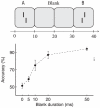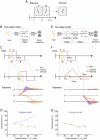Paradoxical evidence integration in rapid decision processes
- PMID: 22359494
- PMCID: PMC3280955
- DOI: 10.1371/journal.pcbi.1002382
Paradoxical evidence integration in rapid decision processes
Abstract
Decisions about noisy stimuli require evidence integration over time. Traditionally, evidence integration and decision making are described as a one-stage process: a decision is made when evidence for the presence of a stimulus crosses a threshold. Here, we show that one-stage models cannot explain psychophysical experiments on feature fusion, where two visual stimuli are presented in rapid succession. Paradoxically, the second stimulus biases decisions more strongly than the first one, contrary to predictions of one-stage models and intuition. We present a two-stage model where sensory information is integrated and buffered before it is fed into a drift diffusion process. The model is tested in a series of psychophysical experiments and explains both accuracy and reaction time distributions.
Conflict of interest statement
The authors have declared that no competing interests exist.
Figures


 and
and  of stimulus ‘A’ and ‘B’ are equal,
of stimulus ‘A’ and ‘B’ are equal,  . (B) One-stage model. After a sensory delay, the stimulus input is directly fed into the decision stage as the drift rate of a decision variable which is subject to a random walk. When the decision variable hits the upper boundary (
. (B) One-stage model. After a sensory delay, the stimulus input is directly fed into the decision stage as the drift rate of a decision variable which is subject to a random walk. When the decision variable hits the upper boundary ( ), the decision is for the offset of the first vernier (stimulus ‘A’). When it hits the lower boundary (
), the decision is for the offset of the first vernier (stimulus ‘A’). When it hits the lower boundary ( ), the decision is for the offset of the second vernier (stimulus ‘B’). A motor response is executed accordingly. Variability in the drift leads to different reaction times (red and blue curves show reaction time distributions). It is important to note that observers push one button for left responses and one for right responses. In this figure, however, button ‘A’ is a symbol denoting responses according to the first vernier stimulus (either left or right) and button ‘B’ according to the second vernier stimulus. (C) Upper panel: After preprocessing and signal transmission of duration
), the decision is for the offset of the second vernier (stimulus ‘B’). A motor response is executed accordingly. Variability in the drift leads to different reaction times (red and blue curves show reaction time distributions). It is important to note that observers push one button for left responses and one for right responses. In this figure, however, button ‘A’ is a symbol denoting responses according to the first vernier stimulus (either left or right) and button ‘B’ according to the second vernier stimulus. (C) Upper panel: After preprocessing and signal transmission of duration  (sensory delay), the one-stage model translates the time course of the input directly into a time-varying drift rate of the decision process. Bottom panel: The time-varying drift rate directly drives the drift-diffusion process leading to trajectories which first increase and then decrease (orange trajectory,
(sensory delay), the one-stage model translates the time course of the input directly into a time-varying drift rate of the decision process. Bottom panel: The time-varying drift rate directly drives the drift-diffusion process leading to trajectories which first increase and then decrease (orange trajectory,  = 10 ms; purple,
= 10 ms; purple,  = 40 ms). The earlier the decision variable hits one of the boundaries, the faster the reaction times. For short
= 40 ms). The earlier the decision variable hits one of the boundaries, the faster the reaction times. For short  (e.g. 10 ms) the trajectory does not reach any of the boundaries (
(e.g. 10 ms) the trajectory does not reach any of the boundaries ( ,
,  ) during stimulus presentation. One of the boundaries is reached after a random walk (orange line and reaction time distributions). For longer durations, the trajectory (purple line) more likely hits the upper than the lower boundary, leading to a decision for stimulus ‘A’. In few cases, a decision for stimulus ‘B’ is made because of the noise (purple reaction time distributions). (D) Experiment 1. In the psychophysical experiments, dominance is quantified as the percentage of responses which are in accordance with the first vernier. According to the one-stage model, vernier dominance increases when total stimulus duration increases (blue line), in stark contrast to the performance of human observers (green line; mean dominance across observers; error bars represent standard error of means, SEM). For the model, dominance is quantified as the percentage of trials in which the diffusion process hits the upper boundary (
) during stimulus presentation. One of the boundaries is reached after a random walk (orange line and reaction time distributions). For longer durations, the trajectory (purple line) more likely hits the upper than the lower boundary, leading to a decision for stimulus ‘A’. In few cases, a decision for stimulus ‘B’ is made because of the noise (purple reaction time distributions). (D) Experiment 1. In the psychophysical experiments, dominance is quantified as the percentage of responses which are in accordance with the first vernier. According to the one-stage model, vernier dominance increases when total stimulus duration increases (blue line), in stark contrast to the performance of human observers (green line; mean dominance across observers; error bars represent standard error of means, SEM). For the model, dominance is quantified as the percentage of trials in which the diffusion process hits the upper boundary ( ). (E) Two-stage model. The input is first integrated, before it is buffered and fed as a constant drift into the drift-diffusion process. (F) The input is delayed by
). (E) Two-stage model. The input is first integrated, before it is buffered and fed as a constant drift into the drift-diffusion process. (F) The input is delayed by  and integrated with a leak. The value of the first stage is read out after stimulus termination
and integrated with a leak. The value of the first stage is read out after stimulus termination  , written into a buffer, and fed as a constant drift rate into the diffusion process at times greater than
, written into a buffer, and fed as a constant drift rate into the diffusion process at times greater than  . Longer input durations lead to stronger negative drifts. Hence, the probability to hit the lower boundary
. Longer input durations lead to stronger negative drifts. Hence, the probability to hit the lower boundary  increases with increasing vernier durations. (G) Performance of the two-stage model (purple line) is similar to the performance of human observers for total durations up to 80 ms (green circles, same human data as in D).
increases with increasing vernier durations. (G) Performance of the two-stage model (purple line) is similar to the performance of human observers for total durations up to 80 ms (green circles, same human data as in D).
 is followed by a second vernier with opposite offset direction (stimulus ‘B’) of duration
is followed by a second vernier with opposite offset direction (stimulus ‘B’) of duration  . (B) The longer the first vernier stimulus is presented, the stronger is its dominance (green circles). If first and second verniers are of the same duration, the second vernier dominates performance, i.e. performance is below 50% (dashed line). Relative vernier duration,
. (B) The longer the first vernier stimulus is presented, the stronger is its dominance (green circles). If first and second verniers are of the same duration, the second vernier dominates performance, i.e. performance is below 50% (dashed line). Relative vernier duration,  , is plotted on the abscissa, mean vernier dominance across observers is plotted on the ordinate. The two-stage model (purple line) fits the psychophysical data well. (C) The 10% (downward pointing triangles) and 25% fastest responses (squares) vary only slightly with the relative vernier duration. The median (circles), the 75% quantile (diamonds) and 90% quantile show a strongly inverted U-shaped pattern (mean across observers). When either the first or the second vernier clearly dominate performance, response times are shorter than when first and second vernier are equally long (relative vernier duration 0.5). The two-stage model (purple lines) fits the psychophysical data well. (D) Mean response times across observers for the responses to the first vernier (red circles) and the second vernier (blue circles) show a similar pattern. The two-stage model captures this behavior well (solid lines). Error bars represent SEM.
, is plotted on the abscissa, mean vernier dominance across observers is plotted on the ordinate. The two-stage model (purple line) fits the psychophysical data well. (C) The 10% (downward pointing triangles) and 25% fastest responses (squares) vary only slightly with the relative vernier duration. The median (circles), the 75% quantile (diamonds) and 90% quantile show a strongly inverted U-shaped pattern (mean across observers). When either the first or the second vernier clearly dominate performance, response times are shorter than when first and second vernier are equally long (relative vernier duration 0.5). The two-stage model (purple lines) fits the psychophysical data well. (D) Mean response times across observers for the responses to the first vernier (red circles) and the second vernier (blue circles) show a similar pattern. The two-stage model captures this behavior well (solid lines). Error bars represent SEM.
References
-
- Newell A. Human Problem Solving. Upper Saddle River, NJ, USA: Prentice-Hall, Inc; 1972.
-
- Tversky A, Kahneman D. The framing of decisions and the psychology of choice. Science. 1981;211:453–458. - PubMed
-
- Platt ML, Glimcher PW. Neural correlates of decision variables in parietal cortex. Nature. 1999;400:233–238. - PubMed
-
- Sugrue LP, Corrado GS, Newsome WT. Choosing the greater of two goods: neural currencies for valuation and decision making. Nat Rev Neurosci. 2005;6:363–375. - PubMed
-
- Bogacz R. Optimal decision-making theories: linking neurobiology with behaviour. Trends Cogn Sci. 2007;11:118–125. - PubMed
Publication types
MeSH terms
LinkOut - more resources
Full Text Sources

